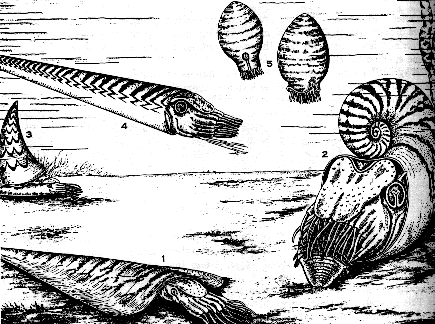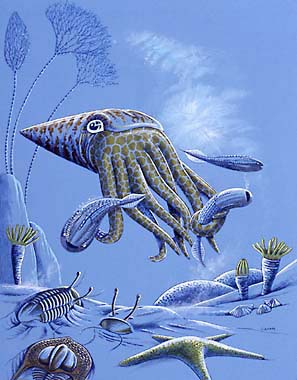Ordovician Period 505 Million Years Ago
When the Ordovician Period started 505 million years ago, animal life was found only in the sea. By the time it ended animals had taken their first steps onto land. During this period almost of the world's land was south of the equator. Africa sat over the South Pole, joined to South America, Antarctica, and Australia. Together this massive land masses created what is known as Gondwana. Animals of this period dwell in the shallow seas. Conditions became cold and half of the world's animal species became extinct. Ancient scratch marks created by glaciers show that a large ice cap developed over Gondwana.
 These
extinctions affected the trilobites, which had become the most important
arthropods of the time. One of the group animals that started to appear
were the nautiloids. Unlike earlier mollusks, which lived on the seabed,
nautiloids were able to swim. They could hover motionless above the seabed,
watching prey with well developed eyes. They used a jet-like system like
to dart quickly through the sea. This new way of life was possible by
the unusual nautilod shells. This new developments would allow these animals
to venture in the open water above them, rather than continue to hug the
sea beds.
These
extinctions affected the trilobites, which had become the most important
arthropods of the time. One of the group animals that started to appear
were the nautiloids. Unlike earlier mollusks, which lived on the seabed,
nautiloids were able to swim. They could hover motionless above the seabed,
watching prey with well developed eyes. They used a jet-like system like
to dart quickly through the sea. This new way of life was possible by
the unusual nautilod shells. This new developments would allow these animals
to venture in the open water above them, rather than continue to hug the
sea beds.
During the Ordovician Period the invertebrates still ruled the ocean floor. In Early Cambrian times, their bodies were small, and their exoskeletons, were paper thin. But by the begriming of the Ordovician several lines of arthropods had evolved their exoskeletons in to suits of armor to protect themselves from predators. One group of armored arthropods that were common during the Ordovician was the horseshoe crab. These were members of a line that will later produce spiders and scorpions.
During the Ordovician a rare event took place on the ocean's floor. A completely new group of animals appeared after the Cambrian explosion. Known as bryozoans, were small invertebrates which were protected by boxlike skeletons. They formed colonies, forming shapes that often looked like plants. Bryozoans proved to be a very successful addition to the animal kingdom and are still widespread today.
